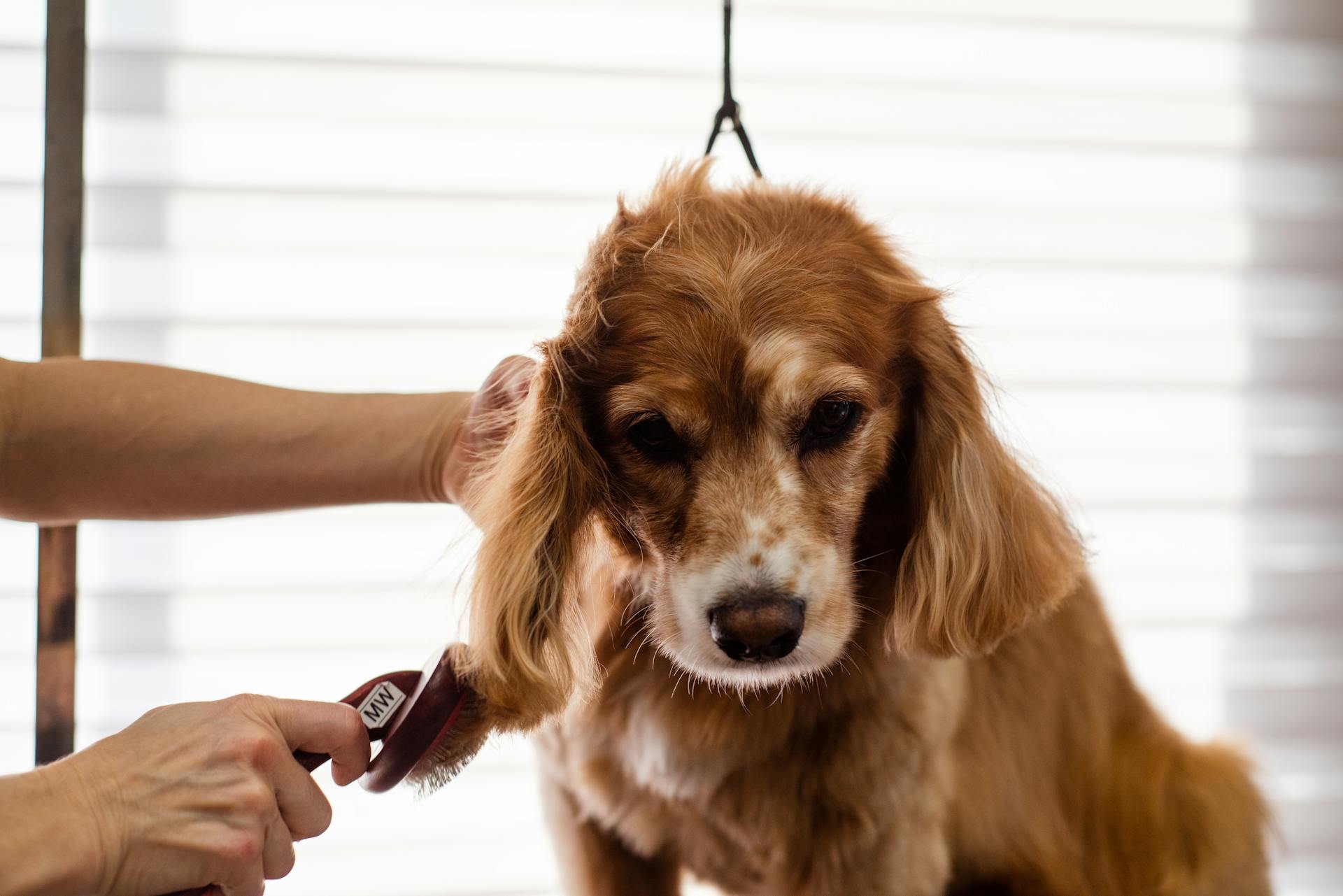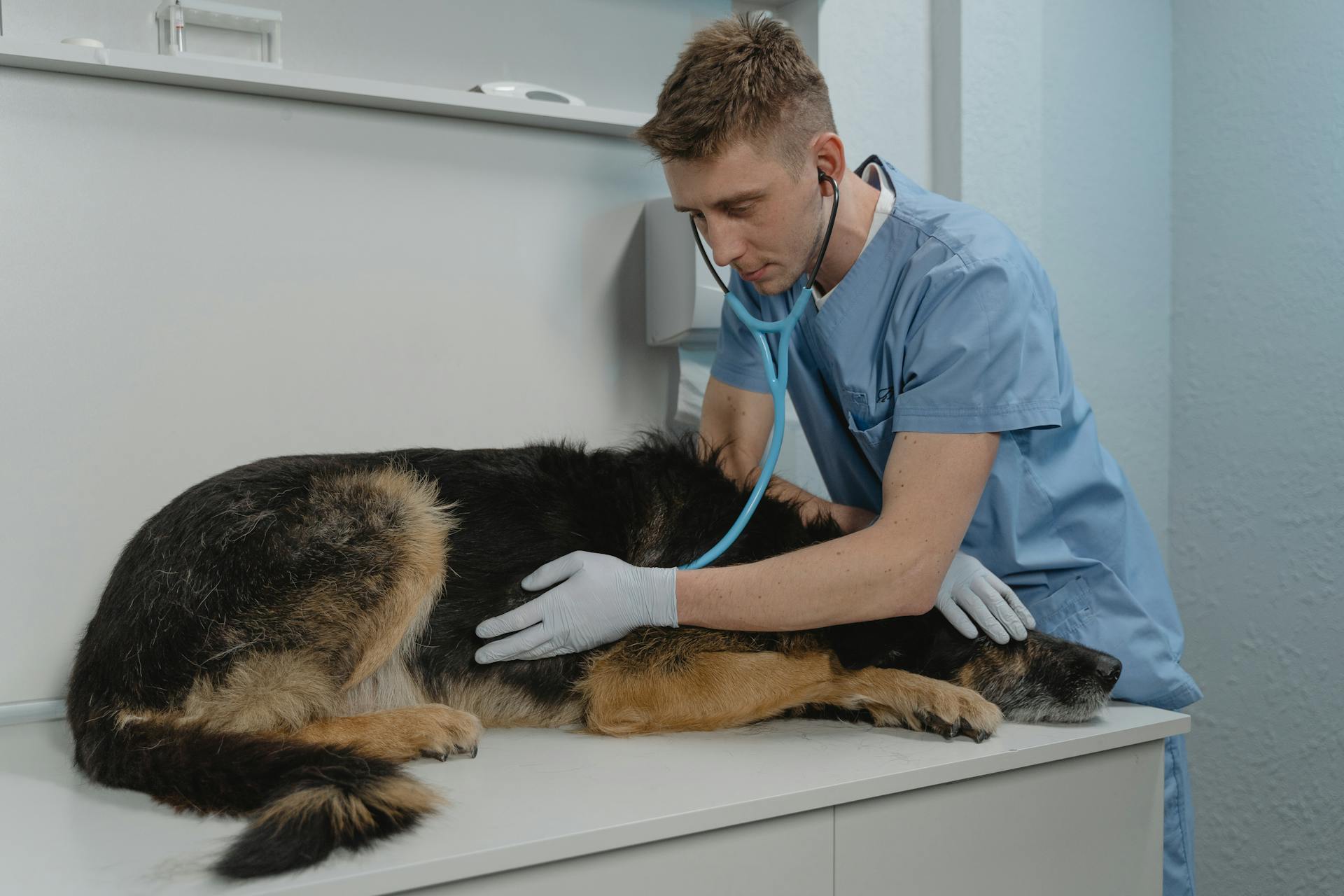
If your dog is sick after grooming, it's essential to identify the root cause to ensure their health and well-being. Stress and anxiety during grooming can lead to a range of symptoms, including vomiting, diarrhea, and lethargy.
Some common reasons for a dog's sickness after grooming include ingestion of grooming products, skin irritation, and allergic reactions. Grooming products can be toxic if ingested, so it's crucial to keep an eye on your dog during and after grooming.
Symptoms of a dog's sickness after grooming can appear immediately or within a few hours. Keep an eye out for signs of distress, such as whining, panting, or restlessness, and seek veterinary attention if you notice any unusual behavior.
You might enjoy: What Does a Flea Infestation Look like on a Dog
Causes and Symptoms
Pseudomonas aeruginosa is the most commonly cultured organism in cases of post-grooming furunculosis, a gram-negative rod-shaped bacterium frequently associated with otitis externa.
Grooming products can be a source of bacteria, including Serratia marcescens, an anaerobic facultative gram-negative bacterium, which has been cultured from affected dogs and shampoos.
A dog's coat can become contaminated with bacteria during grooming, clipping, and skin scrubbing, even with chlorhexidine surgical scrub.
Swimming in ponds and lakes, using an underwater treadmill, or even bathing at home can lead to furunculosis, a condition that can occur after grooming at professional groomers or veterinary clinics.
Furunculosis can be caused by a combination of bacteria, including Pseudomonas and Staphylococcus species, as well as other gram-negative bacteria.
Diagnosis and Treatment
Diagnosis of dog sickness after grooming typically involves a presumptive diagnosis based on history and clinical signs. A bacterial culture is often recommended because of the wide variation in organisms and susceptibility.
To diagnose post-grooming furunculosis, your veterinarian may recommend sampling pyoderma lesions for culture. This involves choosing intact lesions, puncturing the pustule with a needle, and then swabbing the area.
The veterinarian may also take a biopsy and perform histopathology to examine the skin cells and hair follicles. This can help confirm the diagnosis and rule out other causes of the dog's symptoms.
Here are some questions your veterinarian may ask to help diagnose the issue:
These questions can help your veterinarian determine the cause of the dog's sickness and develop an effective treatment plan.
Diagnosis of Post-Grooming
Diagnosis of Post-Grooming Furunculosis typically involves a presumptive diagnosis based on history and clinical signs.
A key part of the diagnosis is identifying the timing of lesions in relation to grooming. Owners often notice the timing of lesions to grooming and assume the pet has been "poisoned" by a shampoo, dip, or flea treatment.
Bacterial culture is recommended because of the wide variation in organisms and susceptibility, both aerobic and anaerobic. Pyoderma lesions can be sampled for culture.
To collect a culture, choose lesions that are intact, puncture the pustule with a needle, and then swab. Aspirate and transfer to a swab.
Biopsy and histopathology results typically include cellulitis, folliculitis, furunculosis, inflammatory skin cell inflammation, and neutrophilic inflammation of the follicular wall. Hair follicles are typically obliterated by neutrophils, eosinophils, macrophages, and plasma cells.
To determine the cause of post-grooming furunculosis, you'll need to gather information about the dog's grooming history. Here are some key questions to ask:
- Has the dog been swimming recently?
- Has the dog been groomed recently?
- Where was the dog groomed (home, self-service dog wash, commercial groomer, charity dog wash)?
- Was any other grooming procedure performed at the time of bathing (e.g., coat stripping)?
- What products were used on the dog (brand name, expiration date, Environmental Protection Agency registration number)?
- Was the product mixed per label directions?
- Had the product been mixed at an earlier date?
- Were shampoo and conditioner rinsed off the dog thoroughly?
- Were other animals in the household also bathed, and are those pets symptomatic?
Canine Vestibular Disease Treatment
The exact treatment for canine vestibular disease depends on the severity of the illness and what kind of vestibular disease it is.
They may do blood tests, X-rays, an MRI or a CT scan to rule out other illnesses, though some vets may be confident enough that they treat the animal for vestibular disease before asking you to invest in pricey tests.
The vet may prescribe antibiotics, steroids or medication for nausea, but there’s no one-size-fits-all treatment.
If the vestibular disease was caused by a lack of proper ear cleaning or ear infections, the vet will probably tell you to clean the dog’s ears frequently and may even give you a special solution to do it.
Make sure you ask the vet to show you how to clean the ears as overzealous cleaning can cause the same types of issues.
On a similar theme: Dog Ear Grooming
Staying calm is key, your dog will be distressed enough by the whole situation, so it's essential to remain calm and assume the best until the doctor tells you otherwise.
Learning to properly clean out your dog’s ears and doing it on the schedule recommended by your vet is crucial.
Readers also liked: How to Calm Dog for Grooming
Post-Grooming Care
Most cases of post-grooming furunculosis will respond well to therapy.
Empirical therapy with fluoroquinolones or cephalosporins should be initiated, and antibiotics can be changed according to culture and sensitivity results.
Some dogs may require pain medication, and appropriate nonsteroidal anti-inflammatory drugs are usually effective for pain relief.
Tapering doses of prednisone have been used successfully.
Symptomatic and supportive care, including topical antimicrobials, should be provided as needed.
To prevent post-grooming furunculosis, clients can take the following steps:
- Dilute and mix shampoos and rinses on the day they are used.
- Do not save leftover shampoos and rinses.
- Postpone bathing for 2 weeks after stripping or pin brushing.
- Bring your own shampoos and grooming products to self-serve dog washes.
- Sterilize community-used nozzles and tubs before bathing your dog at a self-serve dog wash.
Understanding Dog Behavior
Dogs can act weird after grooming, and it's often due to the distressing experience they've had.
Grooming can leave most dogs feeling uneasy, and it might take a few days or even a few weeks for them to return to their normal self.
The time it takes for your dog to recover depends on their coat condition and the type of grooming they received.
Some dogs may act strangely for just a few hours, while others may take longer to get back to their usual behavior.
All of it depends on your dog's personality, so be patient and understanding.
Grooming can be quite stressful for your dog, so preparing them beforehand by taking a long walk or playing fetch can help make the experience less overwhelming.
While every dog is different, some dogs may feel a bit worn out, sad, or even appear depressed after a grooming session.
In some cases, especially those in which the grooming session was overdue, the dogs may seem energetic and happy to have a haircut and freshly clipped paw pads.
Selecting the right shampoo and conditioner can make a big difference in your dog's grooming experience, and using a gentle and soothing product can help reduce stress.
A different take: Why Is My Dog so Sleepy after Grooming?
Clinical Presentation

Clinical signs of post-grooming furunculosis typically develop 24 to 48 hours after bathing, hand stripping, or traumatic brushing.
The condition is characterized by severe, painful inflammation around hair follicles, resulting in pustules, bullae, and fistulous tracts, as well as hemorrhagic crusts.
Dogs may also exhibit fever, lethargy, and loss of appetite, with lymphadenopathy often noted on physical exam.
The typical pattern of lesions is found on the dorsal midline and trunk, reflecting the application of shampoos and vigorous rubbing of skin already irritated from brushing and stripping.
In some cases, dogs may be presented with signs of systemic illness before skin lesions have developed, such as sepsis, systemic inflammatory syndrome, and disseminated intravascular coagulopathy.
The infection can be caused by a contaminated shampoo, often containing bacteria like Pseudomonas, which can lead to a serious deep skin infection called furunculosis.
See what others are reading: Dog Ear Infection after Grooming
Sources
- https://todaysveterinarypractice.com/toxicology/post-grooming-furunculosis/
- https://rexipets.com/blogs/the-latest/reasons-why-dog-acting-weird-after-being-shaved
- https://www.dogster.com/dog-health-care/how-do-dogs-feel-after-grooming
- https://www.sheknows.com/living/articles/1043965/canine-vestibular-disease/
- https://www.amcny.org/blog/2023/03/22/the-dangers-of-grooming-your-dog-or-cat/
Featured Images: pexels.com


